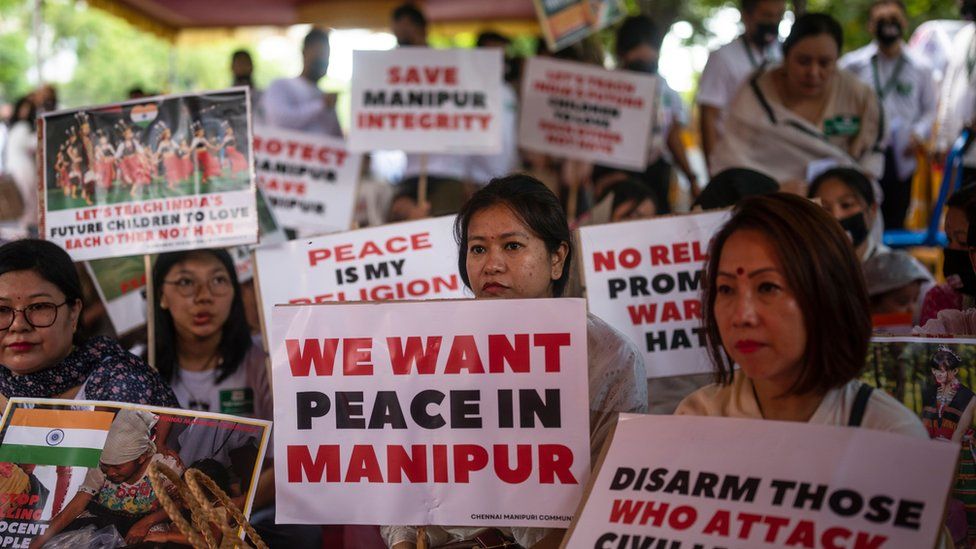Ethnic violence has plunged the small Indian state of Manipur into what many have dubbed a state of civil war as the two largest groups, the majority Meitei and minority Kuki, battle over land and influence.
Shocking video emerged this week of an attack in May when two Kuki women were paraded naked by Meitei men shortly after their village was razed, in the latest use of terror against women in the region.
Where is Manipur and who lives there?
The hilly north-east Indian state sits east of Bangladesh and borders Myanmar. It is home to an estimated 3.3 million people.
More than half are Meiteis, while around 43% are Kukis and Nagas, the predominant minority tribes.
What is happening?
At least 130 people have been killed and 400 wounded in violence that began in May. More than 60,000 have been forced from their homes as the army, paramilitary forces and police struggle to quell violence.
Police armouries have been looted, hundreds of churches and more than a dozen temples ruined, and villages destroyed.

How did it start?
Tensions boiled over when Kukis began protesting against demands from the Meiteis to be given official tribal status, which the Kukis argued would strengthen their already strong influence on government and society, allowing them to buy land or settle in predominantly Kuki areas.
But there are myriad underlying reasons. The Kukis say a war on drugs waged by the Meitei-led government is a screen to uproot their communities.
Illegal migration from Myanmar has heightened tensions. There is pressure on land use from a growing population and unemployment has pushed youth towards the various militias.
Who is fighting whom?
Meitei, Kuki and Naga militias have for decades fought one another over conflicting homeland demands and religious differences, and all sides have clashed with India’s security forces. The latest flare-up, however, is almost entirely between the Meitei and the Kuki.
“This time, the conflict is strictly rooted in ethnicity, not religion,” says Dhiren A Sadokpam, editor of The Frontier Manipur.
Who are the Kuki and Meitei?
The Meitei have roots in Manipur, Myanmar and surrounding areas. The vast majority are Hindu although some follow the Sanamahi religion. The Kukis, mostly Christian, have spread across the north-east of India, and many of those in Manipur can trace their roots back to Myanmar too.
Meiteis mostly live in the Imphal valley, while the Kukis live in the surrounding hills and beyond.
Why are women being attacked and humiliated?
The BBC’s Geeta Pandey in Delhi says the video is the latest example of rape and sexual assault being used as instruments of violence in conflict, which can often worsen into a spiral of revenge attacks.
According to local media, the attack in May came after fake reports a Meitei woman had been raped by Kuki militiamen. This unleashed “a new, deadly cycle of reprisal violence on Kuki tribal women allegedly by Meitei mobs”, The Print says.

What is the central government doing?
Prime Minister Narendra Modi had remained silent on the violence in Manipur up until the video of the 4 May attack emerged this week. He said the incident had “shamed India” and that “no guilty will be spared… what happened with the daughters of Manipur can never be forgiven”.
But many Indians are asking why it has taken so long for him to comment publicly on Manipur.
The Indian government has deployed 40,000 soldiers, paramilitary troops and police to the region in an attempt to stem the latest round of violence. So far, it has resisted calls from tribal leaders to impose direct rule.
But the violence continues to spread and force more villagers from their homes.
Who runs Manipur?
Mr Modi’s Bharatiya Janata Party, which governs India, also runs the state government in Manipur, led by N Biren Singh, a Meitei.
The Meitei also control 40 of the regional parliament’s 60 seats despite totalling 53% of the population. The Kukis say that Mr Singh’s recent war on the cultivation of poppy for the heroin trade targeted Kuki areas.
Mr Singh’s government accused Kuki insurgent groups of inciting the community.
Related Topics
- Violence against women
- Women in India
- India
